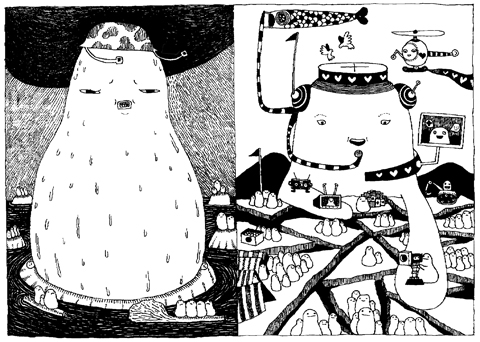It is fashionable these days, particularly in the West, to speak of India and China in the same breath. These are the two big countries said to be taking over the world, the new contenders for global eminence after centuries of Western domination, the Oriental answer to generations of Occidental economic success.
Indeed, two new books explicitly twin the two countries: Robyn Meredith’s The Elephant and the Dragon: The Rise of India and China and What It Means for All of Us and Harvard business professor Tarun Khanna’s Billions of Entrepreneurs: How China and India are Reshaping their Futures — and Yours. Both books view the recent rise of India and China as shifting the world’s economic and political tectonic plates. Some even speak of “Chindia,” as if the two were joined at the hip in the international imagination.
Count me among the skeptics. It is not just that China and India have little in common, save for the fact that they occupy a rather vast landmass called “Asia.” It is also that they are already at very different stages of development. China started its liberalization a decade and a half before India, hit double-digit growth when India was still hovering around 5 percent, and, with compound growth, has put itself in a totally different economic league from India, continuing to grow faster from a larger base.

Moreover, the two countries’ systems are totally dissimilar. If China wants to build a new six-lane expressway, it can bulldoze its way through any village in its path. In India, if you want to widen a two-lane road, you could be tied up in court for a dozen years over compensation entitlements.
When China built the Three Gorges dam, it created a 660km long reservoir that necessitated displacing 2 million people — all accomplished in 15 years without a fuss in the interest of generating electricity.
When India began the Narmada Dam project, aiming to bring irrigation, drinking water, and power to millions, it spent 34 years (so far) fighting environmental groups, human rights activists and advocates for the displaced all the way to the Supreme Court, while still being thwarted in the streets by protesters.
That is how it should be: India is a fractious democracy, China is not. But, as an Indian, I do not wish to pretend that we can compete in the global growth stakes with China.
But if we can’t compete, can we cooperate? The two civilizations had centuries of contact in ancient times. Thanks mainly to the export of Buddhism from India to China, Chinese came to Indian universities, visited Indian courts and wrote memorable accounts of their voyages. Nalanda received hundreds of Chinese students in its time, and a few Indians went the other way; a Buddhist monk from India built the famous Lingyin Si temple in Huangzhou in the 5th century.
Southwest India’s Kerala coastline is dotted with Chinese-style fishing nets, and the favorite cooking pot of the Malayali housewife is the wok, locally called the cheen-chetti (Chinese vessel).
But it has been a while since Indians and Chinese had much to do with each other. The heady days of Hindi-Chini bhai-bhai (“Indians and Chinese are brothers”), the slogan coined by Nehru’s India to welcome Chinese premier Zhou Enlai (周恩來) in 1955, gave way to the humiliation of the 1962 border war, after which it was “Hindi-Chini bye-bye” for decades.
The border dispute remains unresolved, with periodic incursions by Chinese troops onto Indian soil and new irritants such as the anti-Chinese protests by Tibetan exiles who have been given asylum in India. To speak of a bilateral “trust deficit” might be an understatement.
And yet, there is some good news. Trade has doubled in each of the last three years, to an estimated US$40 billion this year; China has now overtaken the US as India’s largest single trading partner. Tourism, particularly by Indian pilgrims to the major Hindu holy sites in Tibet, Mount Kailash and Lake Mansarovar, is thriving.
Indian information technology firms have opened offices in Shanghai and Hangzhou, and Infosys recruited nine Chinese this year for its headquarters in Bangalore. There are dozens of Chinese engineers working in (and learning from) Indian computer firms and engineering companies, while Indian software engineers support the Chinese telecoms equipment manufacturer Huawei.
By and large, India is strong in areas in which China needs to improve, notably software, while China excels at hardware and manufacturing, which India sorely lacks. So India’s Mahindra and Mahindra company manufactures tractors in Nanchang for export to the US. The key operating components of Apple’s iPod were invented by the Hyderabad company PortalPlayer, while iPods are manufactured in China.
Philips employs nearly 3,000 Indians at its “Innovation Campus” in Bangalore to write more than 20 percent of the company’s global software, which Philips’ 50,000-strong workforce in China then turns into brand-name goods.
In other words, the elephant is already dancing with the dragon. The only question is whether political tensions could bring the music screeching to a halt. There is no doubt that, whatever India’s legitimate differences with China, cooperation is in the best interests of both peoples. After all, one plus one doesn’t only equal two; put together properly, it can add up to 11.
Shashi Tharoor, an acclaimed novelist and commentator, is a former under-secretary-general of the UN.
COPYRIGHT: PROJECT SYNDICATE

China has not been a top-tier issue for much of the second Trump administration. Instead, Trump has focused considerable energy on Ukraine, Israel, Iran, and defending America’s borders. At home, Trump has been busy passing an overhaul to America’s tax system, deporting unlawful immigrants, and targeting his political enemies. More recently, he has been consumed by the fallout of a political scandal involving his past relationship with a disgraced sex offender. When the administration has focused on China, there has not been a consistent throughline in its approach or its public statements. This lack of overarching narrative likely reflects a combination
US President Donald Trump’s alleged request that Taiwanese President William Lai (賴清德) not stop in New York while traveling to three of Taiwan’s diplomatic allies, after his administration also rescheduled a visit to Washington by the minister of national defense, sets an unwise precedent and risks locking the US into a trajectory of either direct conflict with the People’s Republic of China (PRC) or capitulation to it over Taiwan. Taiwanese authorities have said that no plans to request a stopover in the US had been submitted to Washington, but Trump shared a direct call with Chinese President Xi Jinping (習近平)
Heavy rains over the past week have overwhelmed southern and central Taiwan, with flooding, landslides, road closures, damage to property and the evacuations of thousands of people. Schools and offices were closed in some areas due to the deluge throughout the week. The heavy downpours brought by the southwest monsoon are a second blow to a region still recovering from last month’s Typhoon Danas. Strong winds and significant rain from the storm inflicted more than NT$2.6 billion (US$86.6 million) in agricultural losses, and damaged more than 23,000 roofs and a record high of nearly 2,500 utility poles, causing power outages. As
The greatest pressure Taiwan has faced in negotiations stems from its continuously growing trade surplus with the US. Taiwan’s trade surplus with the US reached an unprecedented high last year, surging by 54.6 percent from the previous year and placing it among the top six countries with which the US has a trade deficit. The figures became Washington’s primary reason for adopting its firm stance and demanding substantial concessions from Taipei, which put Taiwan at somewhat of a disadvantage at the negotiating table. Taiwan’s most crucial bargaining chip is undoubtedly its key position in the global semiconductor supply chain, which led